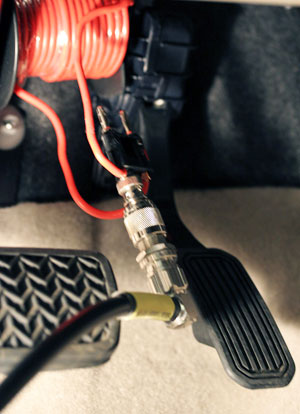Electronic Throttle Control
- Basic Description
-

In traditional vehicle designs, stepping on the accelerator pedal moves a
cable that is mechanically connected to a butterfly valve in the engine's throttle.
The position of this valve directly controls the amount of air supplied to the cylinders and
consequently determines the engine speed and torque. Most vehicles on the road today have electronic
throttle controls. In these vehicles, stepping on the accelerator pedal sends an electrical signal to the engine control module (ECM).
The ECM uses this information to send a control signal to an electric motor mounted to the
throttle body that adjusts the position of the butterfly valve accordingly. A throttle position sensor is used to create a closed-loop control system to ensure that the throttle is open to the correct position.
A major advantage of an electronic throttle is that it can be easily linked to other systems such as engine control, traction control, electronic stability control and cruise control. These other systems are able to take control of the throttle when necessary to help improve vehicle safety, convenience and fuel economy. For example, the National Highway traffic Safety Administration has proposed a rule that all cars be required to have a brake-throttle override (BTO) system in place by September of 2014. The BTO system would give priority to brake inputs when the brake pedal and the accelerator pedal were engaged at the same time.
Like all of the electronic systems controlling safety critical functions in a vehicle, electronic throttle controls are designed with certain fail-safe features, including redundant sensors and self-diagnostic capabilities. The image on the right illustrates a magnetic field immunity test being performed on an accelerator pedal that employs hall-effect sensors.
A simple demonstration of how electronic throttle controls work can be found
here.
- Sensors
- Pedal position sensors, throttle valve position sensors
- Actuators
- Motor on throttle body
- Data Communications
- Typically a CAN bus connection between the ECM and other systems capable of controlling the throttle.
- Manufacturers
- Bosch, Continental, Delphi,
Denso,
Hitachi, KMS,Magneti Marelli
- For More Information
- [1] Electronic Throttle Control, Wikipedia.
- [2] Electronic Throttle Control (Drive By Wire or Fly By Wire), Pico Technology web site.
- [3] Electronic Throttle Control, YouTube, Feb. 8, 2010.
- [4] Electronic Throttle Control Advances, Michael Knowling, Autospeed.com, 2001.
- [5] Lexus Safety Features of Electronic Throttle Control Systems (ETCS), YouTube, Mar. 26, 2010.
- [6] BMW Multi-Butterfly Throttle Control, YouTube, Apr. 6, 2012.
- [7] Electronic Throttle Controls, YouTube, May 8, 2013.
|

